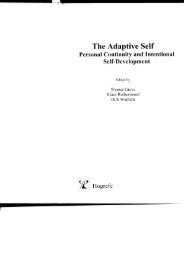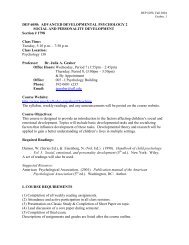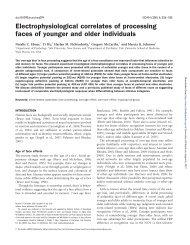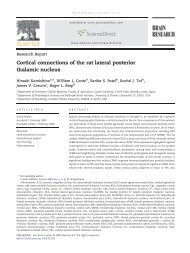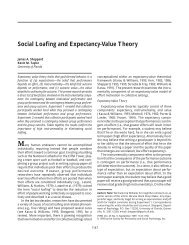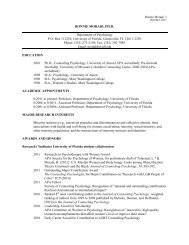Personality theories of successful aging - University of Florida ...
Personality theories of successful aging - University of Florida ...
Personality theories of successful aging - University of Florida ...
You also want an ePaper? Increase the reach of your titles
YUMPU automatically turns print PDFs into web optimized ePapers that Google loves.
<strong>Personality</strong> Theories <strong>of</strong> Successful Agirtg 103<br />
milar results rvith cogrpeting<br />
tasks. Bondar,<br />
er adults could be in-<br />
Lents. In the case <strong>of</strong> a<br />
however, older adults<br />
ntial allocation system<br />
lms to be adaptive to<br />
;ts that there exists cules<br />
and that SOC is reaged,<br />
and older adults.<br />
eas younger adults are<br />
rr adults show a higher<br />
racting losses. Studies<br />
heir resources to those<br />
ival.<br />
I research strengthens<br />
aptive developmental<br />
el can be regarded as a<br />
: span development. lt<br />
r to master the general<br />
ranges in goal-relevant<br />
mmodative coping by<br />
r, 1990), also places a<br />
ccessful development.<br />
ATIVE AND<br />
rework to understand<br />
tion and real-location<br />
l accommodative coptiidter<br />
& Greve,7994;<br />
2002; Brandtsteidter &<br />
;elf-regulatory stratecourses<br />
<strong>of</strong> individual<br />
I (e.g., tenacious goal<br />
adjustment). Specifi-<br />
I efforts to change Iife<br />
ls to personal preferental,<br />
self-corrective,<br />
tentionally changing<br />
rdy appearance to the<br />
justment <strong>of</strong> personal<br />
es to situational cong,<br />
or disengagement<br />
riration levels, rescal-<br />
ing criteria <strong>of</strong> success, or even selecting new, feasible goals. Accommodation includes<br />
emotional and cognitive reappraisal; it cannot be initiated intentionally, but<br />
shapes the selection <strong>of</strong> goals, and thus constitutes a basic mechanism <strong>of</strong> action regulation<br />
in the face <strong>of</strong> loss.<br />
The model specifies differential situational conditions that selectively activate<br />
or inhibit the two modes <strong>of</strong> coping. Assimilative tendencies dominate as long as<br />
people feel able to actively change a given situation. When experiences <strong>of</strong> loss increase<br />
or assimilative attempts to change the situation are ineffective and actionoutcome<br />
expectancies become low, accommodative tendencies are activated. This<br />
is also the case when assimilative modes are inefficient from the outset. Thus, people<br />
<strong>of</strong>ten first employ assimilative coping efforts to actively overcome obstacles<br />
that block their goals. If these attempts are un<strong>successful</strong>, a gradual shift to accommodative<br />
processes <strong>of</strong> goal adjustment occurs, which is modulated by personal<br />
and situational factors (e.g., goal importance; Brandtstiidter & Wentura,7995).<br />
According to the model, goal attainment leads to positive affect. Negative emotions<br />
arise when losses <strong>of</strong> goal-relevant resources lead to unattainability <strong>of</strong> goals<br />
and one falls short <strong>of</strong> one's ambitions and personal standards. Discrepancies between<br />
actual states and desired outcomes become especially salient in later phases<br />
<strong>of</strong> life when irrevocable Iosses and uncontrollable events cumulate. Brandtstddter<br />
and colleagues (Brandtstadter,1,999; Brandtstiidter & Greve, 7994;Brandtstiidter &<br />
Renner, 1990) maintain that in old age this growing impact <strong>of</strong> negative events on<br />
personal development favors an age-related shift from an active, assimilative to a<br />
more accepting, accommodative coping. As the aim <strong>of</strong> accommodative coping is to<br />
make the given situation appear less negative and more acceptable, this strategy<br />
may help individuals to maintain positive developmental perspectives into old age.<br />
With declining resources, as is especially the case in old age, it may not be possible<br />
to maintain the highest standard in multiple domains (Brandtstiidter & Wentura,<br />
1995). Accommodative coping therefore becomes particularly effective to protect<br />
against decline in well-being and favors adaptive development in later life (see also<br />
Heckhausen & Schulz, 1995). Thus, the dual-process model <strong>of</strong> coping characterizes<br />
<strong>successful</strong> <strong>aging</strong> primarily as a shift from actively counteracting the onset <strong>of</strong> agerelated<br />
losses to cognitively restructuring personal goals and standards.<br />
Aoerrrvu Drvrlc-rt'vENr es Srttr-r'INC FRoM Asstl,rtlantvn ro<br />
AccoHavopnrtve CctptNC THRouGHour LIFE<br />
Empirical evidence supports the expectation <strong>of</strong> age-related differences in the empioyment<br />
<strong>of</strong> assimilative and accommodative coping strategies. In a self-report<br />
study with younger, middle-aged, and older adults, Brandtstiidter and Renner<br />
(1990) found that self-reported tenacious goal pursuit and flexible goal adjustment<br />
were complementarily associated with age. There was an age-graded gradual shift<br />
from active, tenacious goal pursuit to accepting, flexible goal adjustment. In addition,<br />
the study demonstrated a buffering effect <strong>of</strong> flexible goal adjustment with<br />
regard to the impact <strong>of</strong> perceived deficits on dissatisfaction with personal development.<br />
This finding suggests that flexibly adjusting one's goals helps to maintain a<br />
sense <strong>of</strong> well-being and satisfaction despite the actual experience <strong>of</strong> loss'<br />
In a large sample <strong>of</strong> older adults, Rothermund and Brandtst2idter (2003) found<br />
that accommodative strategies to overcome functional impairments had a curvilinear,<br />
inverted U-shaped relationship to age. The strategies increased up to the



